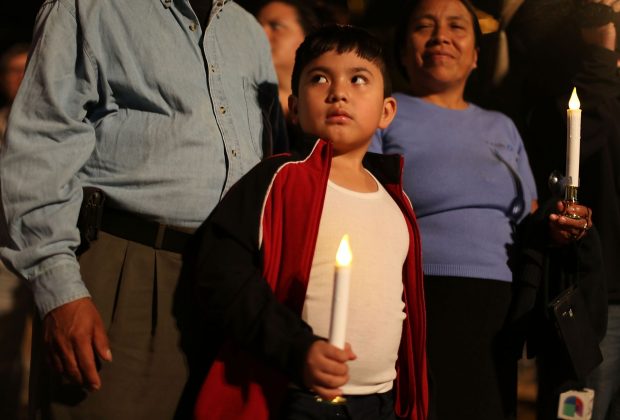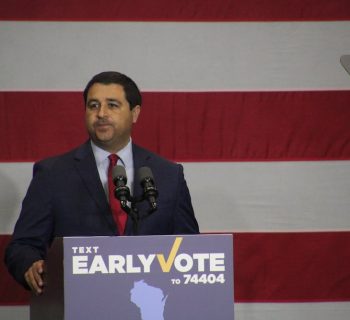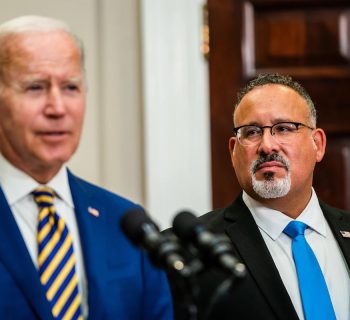By: Dara Lind ~ Vox ~ March 5, 2018
Trump’s policies are throwing whole communities into distress — and warping the daily lives of unauthorized immigrants, legal immigrants, and US citizen children alike.
The director of Immigration and Customs Enforcement (ICE), the agency responsible for deporting unauthorized immigrants living in the United States, likes to say that immigrants should be afraid of deportation: “If you entered this country illegally,” said Tom Homan in June 2017, “you should be looking over your shoulder and you should be worried.”
Two new studies offer evidence for a disturbing reality: The fear is real — but it isn’t limited to unauthorized immigrants. It’s affecting other immigrants who have reason to feel their immigration status isn’t secure. And it’s trickling down to US citizen children of immigrants, and even their children’s classmates. It’s shaping their behaviors and weighing down their inner lives.
We’re beginning to get a more detailed picture of the miasma of fear hanging over immigrants in the Trump era, and the ways it’s seeping into daily life. Two recent studies — one from researchers at George Washington University, based on a survey of Latino parents of teenagers, and another from the UCLA Civil Rights Project, which surveyed school professionals — help demonstrate that the fear of family separation is pressing down on immigrant parents and families. It’s a fear they aren’t equipped to handle, and that’s being passed on, deliberately or inadvertently, to children born in the US.
Immigrant parents are “often” guided by worry — and it’s not just unauthorized immigrants
The George Washington University study, published in the Journal of Adolescent Health, is based on a survey of 213 parents of adolescent children in “a large mid-Atlantic city.” The subjects in the study weren’t necessarily representative of the broader immigrant population: They were overwhelmingly Central American (55 percent of all respondents were born in El Salvador), while Mexican immigrants made up only 8 percent of the sample.
What the survey was equipped to do, however, was compare immigrants — and families — across a variety of immigration statuses. A third of parents were unauthorized immigrants; a sixth had Temporary Protected Status (TPS), which is given to people in the US from countries that have suffered natural disasters or civil war; a third were green card holders; and a sixth were US citizens.
Importantly, most (70 percent) of the teenage children in these families — regardless of their parents’ immigration status — were US citizens.
The study’s authors expected to find that unauthorized immigrants were worrying about immigration enforcement and changing their behavior (and what they told their kids) accordingly. But study author Kathleen Roche says, “We were quite struck by the impacts on parents living in the US legally” — in particular, parents who had TPS.
Over the time the researchers were conducting the survey, the Trump administration announced it was going to stop extending protections under TPS to Haitians and Nicaraguans, causing them to lose their immigration status in 2019. That news didn’t directly affect the (mostly Salvadoran) parents in the study with TPS, but “the parents were aware that these changes were coming or expecting the possibility,” Roche said.
They were right: In January, the administration announced it would end TPS for Salvadoran immigrants as well. (The Trump administration’s move will strip protections from immigrants who’d held them since 2001, when the George W. Bush administration extended TPS to Salvadorans after an earthquake.)
The overwhelming majority of parents with TPS said they worried about family separation (84 percent), or worried it would be hard for their child to finish school (76 percent). Seventy-eight percent had often warned their children to stay away from authorities; 65 percent had often talked to their children about changing their behavior, “such as where he/she hangs out”; 62 percent said they’d often avoided medical care, police, or other services.
Unauthorized parents were primarily worried about their family’s all-around well-being. Eighty-eight percent often worried about family separation. Seventy percent said it was often hard to imagine being in a better job or making more money, while 60 percent often worried it would be hard for their child to get a job. And 58 percent worried it would be hard for their child to finish school.
But they were less likely than parents with TPS to have frequently shared those concerns with their children in recent months. While 78 percent of parents with TPS often warned their children to stay away from authorities, 55 percent of undocumented parents did. While 65 percent of parents with TPS talked to children about changing other behaviors like where they hung out, 53 percent of undocumented parents did.
Immigrants were asked a 14-question battery to measure their current “psychological distress,” including symptoms of depression and anxiety; the study authors labeled the top quarter of scores “highly” distressed. Only 23 percent of the unauthorized immigrant parents hit that threshold, making their scores pretty proportional of respondents as a whole; in fact, slightly more green card-holding parents scored high levels of distress (only 8 percent of US citizen parents did). But nearly half of all parents who had TPS scored as highly distressed.
The high rates of distress make sense, given the administration’s recent moves to stop extending TPS to certain groups. It would be hard to scramble to adapt to a life, and a set of concerns, that you’ve never had to worry about before. And it makes sense that you’d have these concerns in mind even if you aren’t yet 100 percent sure that they’ll become a problem for you.
The GW study puts that difficulty in real, human terms — and makes it incredibly clear that the Trump administration’s actions are expanding the pool of vulnerability and changing how affected immigrants live their lives.
Parents aren’t anxious about themselves — they’re anxious about their kids
What didn’t matter for parents’ response to immigration news in the GW survey was the immigration status of their teenage kids. Parents of US citizens — 70 percent of respondents — were just as likely to tell their children to stay away from authorities and change their routines as parents of noncitizens, even though citizen teenagers wouldn’t be at risk of getting turned over to ICE. (It’s not likely that this was a reflection of fears about racial profiling more generally, because Latino parents who were US citizens themselves were much less concerned.)
Parents of US citizens were also just as likely to report that they often worried their children would struggle to finish school or that they often felt their children had already been adversely affected by living under the current immigration regime.
Worries for children were most closely connected to psychological distress. Controlling for other variables, parents who often or almost always worried their child had been negatively affected by immigration actions were more than 10 times as likely to test for high psychological distress as parents who weren’t as worried.
Parents who often worried their children would have a hard time finishing school were almost 10 times as likely to be highly distressed as parents who weren’t as concerned about school performance. Parents who had often told their children to change their behavior were almost nine times as likely to be highly distressed.
All of these worries about their children were more closely linked to psychological distress than parents’ worries about their own well-being.
Being a noncitizen in the US — especially one whose status is subject to the whims of the Trump administration — is a stress factor. And it’s not one that parents can protect their children from, either.
The “pyramid” of vulnerability
“We do know from extensive research,” says Roche of GW, “that when parents suffer from anxiety and depression, those teenagers are at much elevated risk of failing in school, engaging in substance use, having their own mental health problems.”
Parents may not be able to cite all the research, but they’re often wary of passing their anxieties onto their children. Immigrant parents of young children often find themselves trying to shield their kids from their own distress. Even the parents Roche studied, whose adolescent kids are much more likely to be aware of what’s going on, were torn between the desire to “communicate openly and honestly” and protecting their child from feeling the need to take care of their distressed parents — a teenager taking on a “parent-like, adult role” in the household she didn’t ask for and can’t necessarily handle yet.
That spillover is documented in some detail by a report by Patricia Gándara and Jongyeon (Joy) Ee of the UCLA Civil Rights Project, which surveyed teachers and other school officials from 730 schools (in 24 school districts) across 12 states about the impact they perceived of immigration enforcement in their classrooms.
Surveying educators’ perceptions of their classrooms isn’t a perfect way to measure what’s actually going on — for one thing, teachers might be more sensitive to the well-being of their Latino students under Trump than they were under President Barack Obama, or more likely to draw a connection between emotional difficulties to immigration policy.
But the quotes from teachers and other officials offered in the UCLA report are strikingly consistent. Over and over again, teachers report that children have expressed variations on the same fear in the classroom — a fear the UCLA study’s authors paraphrase as “going home and finding that their parents, siblings, or grandparents are no longer there.”
“Fear” was the most common word used by school employees in the survey responses. “Separation” was the second most common. (This is consistent with the GW study of parents, in which majorities of unauthorized immigrants, TPS holders, and even green card holders expressed fears of family separation.)
That isn’t an irrational fear. One teacher reported, “I had one student who came back the day after prom and would not eat or talk to anyone. I finally found out from one of her friends that she came home from prom to find her mom deported and never had the chance to say good-bye or anything.”
But the fear is still much broader than the direct impact of deportation. One art teacher “saw many students drew and colored images of their parents or themselves being separated, or about people stalking/hunting their family.”
The impact, again, isn’t limited to children who are immigrants themselves. It’s not even necessarily limited to children whose parents are immigrants. Two-thirds of school employees said that concerns about immigration enforcement were affecting their students indirectly. One California teacher said “students are very concerned for their classmates’ future and circumstances. ‘What’s going to happen with so-n-so?’”
The sociologist Joanna Dreby identified this phenomenon in a 2012 study; borrowing a concept from public health of the “injury pyramid,” Dreby called it the deportation “pyramid.” It might be more helpful still to think of it, in the Trump era, as the pyramid of vulnerability.
At the top of the pyramid are those who are directly targeted by detention and deportation; “that group absolutely is going to be the ones who experience the most severe and acute impacts of our policies,” Roche explains. But the indirect effects of that injury trickle downward — to immigrants who may have some legal status but have reason to worry they’ll lose it; to the US-born children of vulnerable immigrant parents; to the classmates (and teachers) of those US-born children; to green card holders who can’t feel entirely safe; and to US citizens worried about their neighbors.
Ultimately, Roche warns, “very large numbers of US Latino families are being impacted — not at such a severe level, but still at a level that is felt in terms of fear and anxiety.”
One year in, it’s becoming increasingly impossible to deny that that’s what’s happening — that the Trump administration’s immigration policy is changing the way large numbers of families, including many US citizen children, understand and live their lives. But the broader public can’t fix the problem, and it’s unclear that the people who have — the government officials who set immigration policy — are paying attention to the effects of the fear factor, or care enough about it to step back from the policies they’re pursuing.
The cause is obvious. And with the slow dissolution of DACA and TPS over the next two years, it’s only likely to get worse.
Source: Dara Lind ~ Vox ~ March 5, 2018







